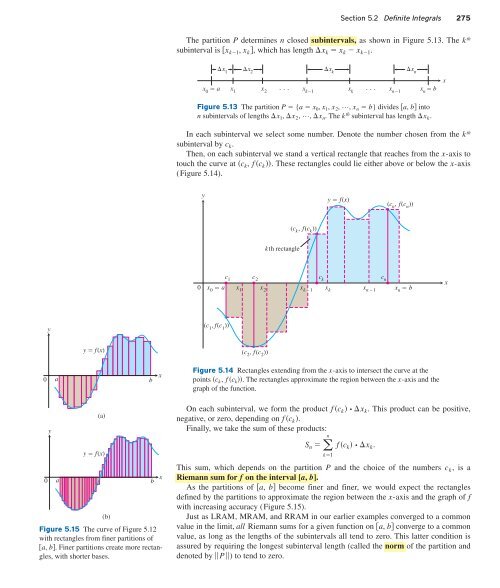FDWK_3ed_Ch05_pp262-319
FDWK_3ed_Ch05_pp262-319
FDWK_3ed_Ch05_pp262-319
Create successful ePaper yourself
Turn your PDF publications into a flip-book with our unique Google optimized e-Paper software.
Section 5.2 Definite Integrals 275<br />
The partition P determines n closed subintervals, as shown in Figure 5.13. The k th<br />
subinterval is x k1 , x k , which has length x k x k x k1 .<br />
x 1 x 2 x k<br />
x 0 a x 1 x 2 • • • x k1<br />
x k • • •<br />
x n<br />
x n1<br />
x n b<br />
x<br />
Figure 5.13 The partition P {a x 0 , x 1 , x 2 , …, x n b} divides a, b into<br />
n subintervals of lengths x 1 , x 2 , …, x n . The k th subinterval has length x k .<br />
In each subinterval we select some number. Denote the number chosen from the k th<br />
subinterval by c k .<br />
Then, on each subinterval we stand a vertical rectangle that reaches from the x-axis to<br />
touch the curve at c k , f c k . These rectangles could lie either above or below the x-axis<br />
(Figure 5.14).<br />
y<br />
y f(x)<br />
(c k , f(c k ))<br />
kth rectangle<br />
c 1 c 2 c k<br />
c n<br />
0 x 0 a x 1 x 2<br />
x k – 1<br />
x n – 1 x n b<br />
x k<br />
(c n , f(c n ))<br />
x<br />
y<br />
(c 1 , f(c 1 ))<br />
y f(x)<br />
(c 2 , f(c 2 ))<br />
0 a<br />
b<br />
x<br />
Figure 5.14 Rectangles extending from the x-axis to intersect the curve at the<br />
points c k , f c k . The rectangles approximate the region between the x-axis and the<br />
graph of the function.<br />
0<br />
y<br />
a<br />
(a)<br />
y f(x)<br />
(b)<br />
Figure 5.15 The curve of Figure 5.12<br />
with rectangles from finer partitions of<br />
a, b. Finer partitions create more rectangles,<br />
with shorter bases.<br />
b<br />
x<br />
On each subinterval, we form the product f c k • x k . This product can be positive,<br />
negative, or zero, depending on f c k .<br />
Finally, we take the sum of these products:<br />
n<br />
S n f c k • x k .<br />
k1<br />
This sum, which depends on the partition P and the choice of the numbers c k , is a<br />
Riemann sum for f on the interval [a, b].<br />
As the partitions of a, b become finer and finer, we would expect the rectangles<br />
defined by the partitions to approximate the region between the x-axis and the graph of f<br />
with increasing accuracy (Figure 5.15).<br />
Just as LRAM, MRAM, and RRAM in our earlier examples converged to a common<br />
value in the limit, all Riemann sums for a given function on a, b converge to a common<br />
value, as long as the lengths of the subintervals all tend to zero. This latter condition is<br />
assured by requiring the longest subinterval length (called the norm of the partition and<br />
denoted by P) to tend to zero.


